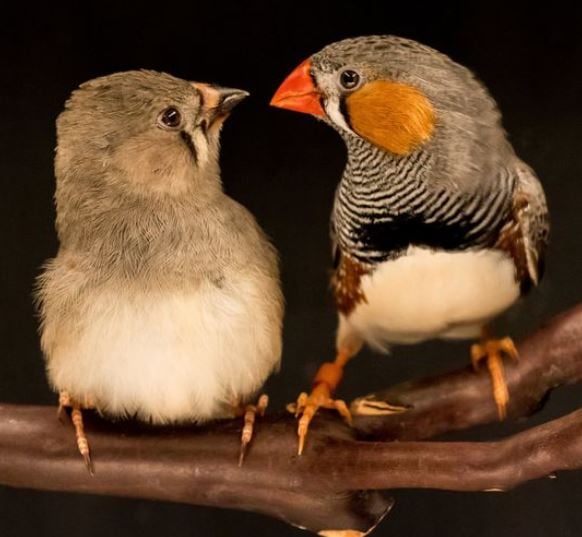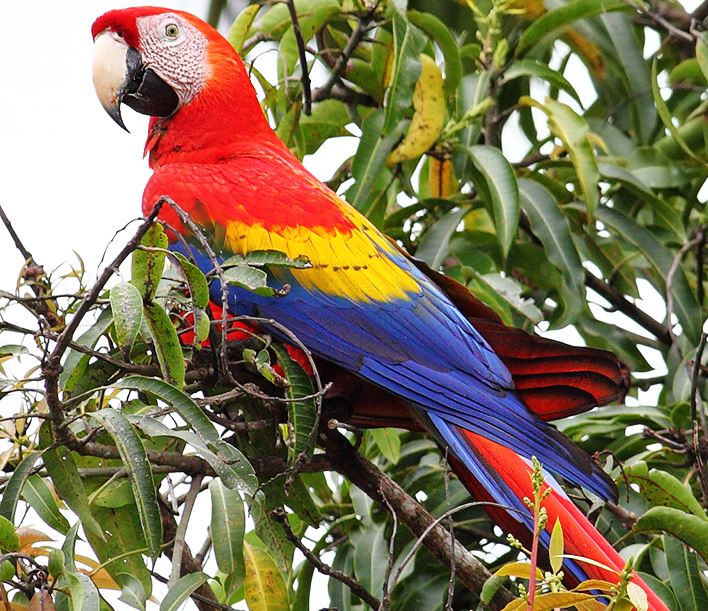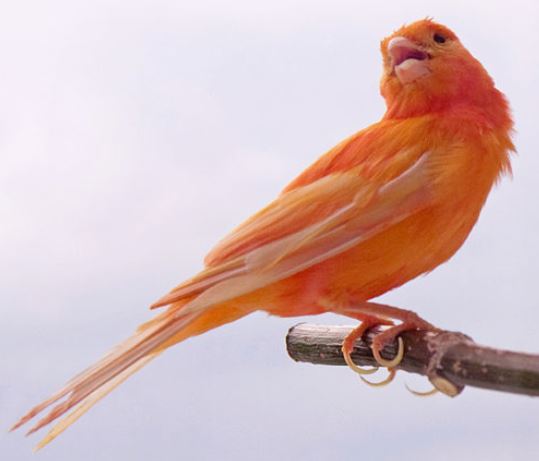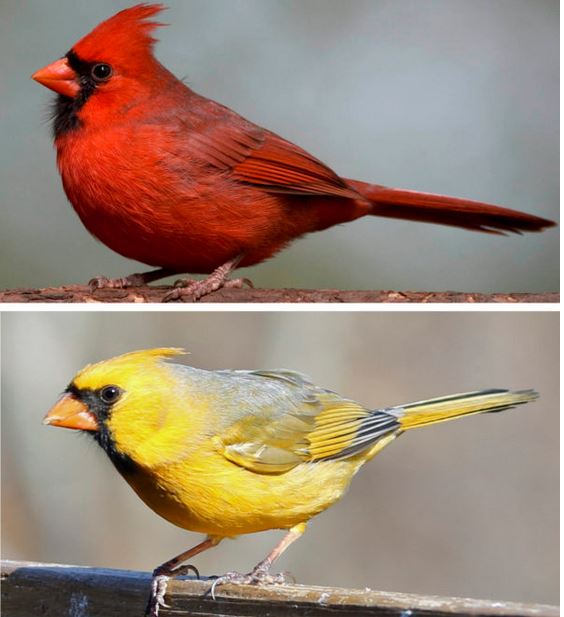The red colour on birds is probably also a signal that they are healthy and good at detox – getting rid of toxins (poisons) from their bodies. The genes that trigger the creation of red pigments found on bird’s beaks, feathers, feet and even their skin, belong to the wider family of genes that also drive detoxification, say two separate studies.
This means that the more red a bird has, and the brighter or more intense that colour is, the better a mate it will probably be – it will attract more females – because it can more effectively get rid of poisons from its body. Female birds seek out healthy males because they want their offspring to have the best genes.
Details on both studies, one carried out using zebra finches, and the other on red factor canaries, were published in two separate articles that appear in this week’s edition of Current Biology (both citations below).
 A wild red-beaked zebra finch (left) and a captive ‘yellowbeak’. Scientists believe that the colour red signals good health. (Image: adapted from cam.ac.uk)
A wild red-beaked zebra finch (left) and a captive ‘yellowbeak’. Scientists believe that the colour red signals good health. (Image: adapted from cam.ac.uk)
The first study – zebra finches
Across the whole bird and animal kingdoms, red is a colour that is used for communication, generally to attract mates and ward of rivals, and zebra finches are no different. The males have a read beak – a sexually selected trait – females prefer suitors with redder beaks.
A team of scientists from the Universities of Cambridge and Sheffield in the UK, and the University of Gothenburg in Sweden, have for the first time identified the genes that trigger the production of the red pigments that play such a major role in attraction and mating.
According to the University of Cambridge:
“The genes belong to a wider family of genes that also play an important role in detoxification, suggesting how heightened redness may be a sign of mate quality: it indicates a bird’s ability to cleanse harmful substances from its body.”
The authors believe that this probably explains what is known as ‘honest signalling’, where a feature that has evolved is a genuine (honest) sign of better and fitter genes, which in this case is the ability to be able to metabolise toxins more effectively.
 A female zebra finch (left) with a red-beaked male. The female is attracted to the colour red because it means her suitor is healthy and can give her strong offspring. (Image: ptinterest.com)
A female zebra finch (left) with a red-beaked male. The female is attracted to the colour red because it means her suitor is healthy and can give her strong offspring. (Image: ptinterest.com)
Zebra finches get yellow pigments – carotenoids – from their diet of seeds, as do many other species. Some birds get their yellow pigments from the insects or fruit they eat.
How do finches transform the yellow into red?
Scientists have always know that birds must have a way of transforming these yellow dietary pigments into the red pigments – ketocarotenoids – that give colour to their plumage, beaks and skin. Nobody knew what the process was, that is, until now.
Jessica Stapley from the University of Sheffield, together with Nick Mundy from Cambridge’s Department of Zoology, and Staffan Andersson from the University of Gothenburg, compared the gene sequences of captive finches that had a mutant, recessive gene that made them have yellow beaks, with a group of wild, red-beaked zebra finches.
They located a cluster of three genes in the wild finches which were either mutated or entirely missing in this genetic region among the ‘yellowbeaks’.
These three genes encode enzymes, known as cytochrome P450s, which play a key role in breaking down and metabolizing toxins, primarily in the livers of vertebrates. There has been plenty of research on humans, because they are strongly linked to drug metabolism.
Dr. Mundy, University Reader in Evolutionary Genetics at Cambridge, said:
“It was known that birds have an unusual ability to synthesize red ketocarotenoids from the yellow carotenoids that they obtain in their diet, but the enzyme, gene or genes, and anatomical location have been obscure.”
“Our findings fill this gap and open up many future avenues for research on the evolution and ecology of red coloration in birds.”
 A scarlet macaw displaying its colourful plumage. The authors believe that the red gene is part of a wider family of genes that are involved in detoxification. (Image: Wikipedia)
A scarlet macaw displaying its colourful plumage. The authors believe that the red gene is part of a wider family of genes that are involved in detoxification. (Image: Wikipedia)
Red linked to physiological process
Birds’ red colour is believed to signal genetic quality in each individual, and the authors argue that one way it can do this is if the concentration of red colour is directly related to another physiological process, such as detoxification.
Staffan Andersson, a professor of Animal Ecology at the Department of Biological & Environmental Sciences, said regarding the old hypothesis:
“Our results, which link a detoxification gene to carotenoid metabolism, shed new light on this old hypothesis about the honesty of signaling.”
The team found the specific expression of at least one of the identified ‘red’ gene cluster in tissues that contained red pigments – the tarsus in the birds’ feet, their beaks, and also in the retina.
Birds’ eyes have cone-shaped photoreceptor cells which contain a range of brightly-coloured oil droplets – red, yellow and green droplets. Mammals don’t have these droplets, that is why birds can see many more colours than we and other mammals can.
As the internal red droplets are found in all bird species, but not all birds have red plumage or beaks, the researchers believes that the production of red pigments evolved for colour vision first, and then later as a function for display.
Dr. Mundy said:
“It was quite a surprise that the same genes are involved both in seeing red colours and making red coloration.”
Other study – red factor canaries
In this study, carried out by scientists from the University of Washington in St. Louis, USA, the University of Oporto in Portugal, and Uppsala University in Sweden, red factor canaries were studied.
The researchers explained in Cell Biology that they discovered the gene that produces the brilliant red colour in male birds that the females like so much.
 A red factor canary, created by breeding a red siskin with the common yellow canary. (Image: medicine.wustl.edu)
A red factor canary, created by breeding a red siskin with the common yellow canary. (Image: medicine.wustl.edu)
They found an enzyme that they believe converts a yellow molecule that birds get by eating fruit, leaves and seeds, into a red one. “This enzyme is active in the eyes of red and yellow birds, where it plays a role in their ability to see color. But in red birds, the enzyme is also active in the skin and feathers,” they wrote.
Co-senior author, Joseph Corbo, MD, PhD, an associate professor of pathology and immunology at Washington University, said:
“In many bird species, the redder the male, the more successful it is at finding mates. Nobody knows for sure why red color is associated with reproductive success.”
“We thought that if we could figure out how they produced that red color, that would help us understand the advantage to being red.”
The red factor canary originated in the first quarter of the last century after commercial breeders crossed a wild South American red siskin with the common yellow canary. The reddest offspring were bred with the canaries again and again until they had a ‘red canary’.
Dr. Corbo and colleagues expected the red factor canaries’ DNA to be almost entirely derived from their canary ancestors, given that so many generations of crossbreeding with yellow canaries took place. There would also be DNA areas related to colouration, which would have originated from the red siskins.
 Researchers have identified the gene that allows the cardinal and other birds to make red feathers. Rare yellow cardinals with defects in the production of red coloration are sometimes observed in the wild. (Image: medicine.wustl.edu)
Researchers have identified the gene that allows the cardinal and other birds to make red feathers. Rare yellow cardinals with defects in the production of red coloration are sometimes observed in the wild. (Image: medicine.wustl.edu)
The genomes of the yellow canary, the red siskin and the red factor canary were compared. Differences in two regions of their genomes were found.
The University of Washington wrote:
“One region contained a gene for an enzyme that is thought to trigger the conversion of the yellow carotenoid into a red one. Corbo and colleagues showed that the gene CYP2J19 was turned on in the skin of red factor canaries, but not in the skin of those that were yellow.”
The other region had a gene involved in the development and growth of skin and feathers.
Dr. Corbo said:
“It seems that, for a bird to grow red feathers, it needs not just the redness gene but also a special form of the gene involved in feather growth. But how the redness gene and the feather growth gene work together to enable red feather coloration is unknown.”
It’s where the gene’s turned on that matters
The difference between yellow and red birds is not in the gene itself, the scientists concluded, after sequencing the gene in yellow and red factor canaries and finding no significant differences. The difference is in parts of the bird’s body where the gene is turned on.
The gene is turned on in just the eyes in yellow canaries, which the authors believe creates red molecules that help birds see colour. In the red factor canaries, however, the gene is turned on in the eye and also in the feathers, skin and liver.
As this gene is widespread in birds, many species may have the potential to have red plumage. However, if the gene is not turned on in the animal’s skin, it doesn’t get the benefit of scarlet feathers.
Dr. Corbo, who is also an associated professor of genetics, ophthalmology and visual science, said:
“There are whole groups of bird species in which the ancestral bird was yellow and most of the daughter species are yellow, too, but here and there you find a red species.”
“It suggests that somewhere along the line that red gene got turned on in the skin, and then it spread throughout the species, maybe by sexual selection.”
The researchers plan to track down the stretches of DNA responsible for turning on CYP2J19 in the red birds’ skin but not the yellow ones. To be able to do this, the scientists are looking for a yellow cardinal.
Dr. Corbo said:
“Every once in a while, a yellow cardinal is spotted in the wild. We hypothesize that this is a rare mutant that is unable to produce the red carotenoid. If we find that yellow cardinals have a mutation in CYP2J19 or its regulatory elements, that would provide even more evidence that this gene is important in red coloration. We’ve got a tiny piece of tissue from a museum specimen, and we’re looking for a mutation now.”
In a Summary that describes the main article, the authors wrote:
“Interestingly, a second introgressed region required for red feathers resides within the epidermal differentiation complex, a cluster of genes involved in development of the integument. Lastly, we present evidence that CYP2J19 is involved in ketocarotenoid formation in the retina.”
“The discovery of the carotenoid ketolase has important implications for understanding sensory function and signaling mediated by carotenoid pigmentation.”
First Citation: “Red Carotenoid Coloration in the Zebra Finch Is Controlled by a Cytochrome P450 Gene Cluster,” Jessica Stapley, Kang-Wook Kim, Terry Burke, Nicholas I. Mundy, Clair Bennison, Hanlu Twyman, Rachel Tucker, Tim R. Birkhead, Staffan Andersson and Jon Slate. Current Biology. 19th May 2016. DOI: 10.1016/j.cub.2016.04.047.
Second Citation: “Genetic Basis for Red Coloration in Birds,” Leif Andersson, Matthew B. Toomey, Ricardo J. Lopes, Miguel Carneiro, Geoffrey E. Hill, Joseph C. Corbo, Pedro M. Araujo, James D. Johnson, Mafalda S. Ferreira and José Melo-Ferreira. Current Biology. 19 May 2016. DOI: 10.1016/j.cub.2016.03.076.
Video – Zebra finch courtship song
In this video, you can see and hear a male zebra finch singing to a female. Although he appears to like her a lot, she does not appear to be that interested in him. Perhaps she is seeking a suitor with a redder beak.
